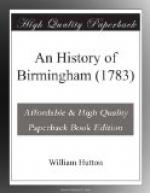One of these subterranean passages, in part filled up, will convey its name to posterity in that of a street, called Holloway-head, ’till lately the way to Bromsgrove and to Bewdley, but not now the chief road to either. Dale-end, once a deep road, has the same derivation. Another at Summer-hill, in the Dudley road, altered in 1753. A remarkable one is also between the Salutation and the Turnpike, in the Wolverhampton road. A fifth at the top of Walmer-lane, changed into its present form in 1764. Another between Gosta-green and Aston-brook, reduced in 1752.
All the way from Dale-end to Duddeston, of which Coleshill-street now makes a part, was sunk five or six feet, though nearly upon a flat, ’till filled up in 1756 by act of Parliament: but the most singular is that between Deritend and Camp-hill, in the way to Stratford, which is, even now, many yards below the banks; yet the seniors of the last age took a pleasure in telling us, they could remember when it would have buried a wagon load of hay beneath its present surface.
Thus the traveller of old, who came to purchase the produce of Birmingham, or to sell his own, seemed to approach her by sap.
British traces are, no doubt, discoverable in the old Dudley-road, down Easy-hill, under the canal; at the eight mile-stone, and at Smethwick: also in many of the private roads near Birmingham, which were never thought to merit a repair, particularly at Good-knaves-end, towards Harborne; the Green-lane, leading to the Garrison; and that beyond Long-bridge, in the road to Yardley; all of them deep holloways, which carry evident tokens of antiquity. Let the curious calculator determine what an amazing length of time would elapse in wearing the deep roads along Saltleyfield, Shaw-hill, Allum-rock, and the remainder of the way to Stichford, only a pitiful hamlet of a dozen houses.
The ancient centre of Birmingham seems to have been the Old Cross, from the number of streets pointing towards it. Wherever the narrow end of a street enters a great thorough-fare, it indicates antiquity, this is the case with Philip-street, Bell-street, Spiceal-street, Park-street, and Moor-street, which not only incline to the centre above-mentioned, but all terminate with their narrow ends into the grand passage. These streets are narrow at the entrance, and widen as you proceed: the narrow ends were formed with the main street at first, and were not, at that time, intended for streets themselves. As the town increased, other blunders of the same kind were committed, witness the gateway late at the east end of New-street, the two ends of Worcester-street, Smallbrook-street, Cannon-street, New-meeting-streer, and Bull street; it is easy to see which end of a street was formed first; perhaps the south end of Moor street is two thousand years older than the north; the same errors are also committing in our day, as in Hill and Vale streets, the two Hinkleys and Catharine-street. One generation, for want of foresight, forms a narrow entrance, and another widens it by Act of Parliament.




